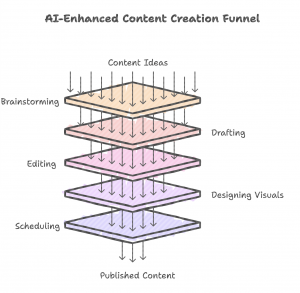Using AI in digital marketing—yay or nay?
Like it or not, this virtual assistant is packed with shortcuts. No need to lay down cash or learn big tech to take advantage of traditional and generative collaborations. By now, using AI in digital marketing is the difference between scaling up or fading out.
Needless to say, it’s crushing the competition…and possibly you. But only if you let it.
Picture this: it’s Monday morning. You’re writing social captions, responding to customer inquiries, editing a blog, and planning next week’s promotional content. And since you’re a business owner, the idea of automating these tasks feels, well, robotic.
First thought: “How can a machine mimic me and stay the course?”
Second thought: “How can my exhaustion limit me if I stay the course?”
The answer to the latter is truly daunting. Because human resources, bookkeeping, product development, and regulatory red tape need your constant supervision too.
Sound familiar? You’re not alone.
Essentially, successful marketing is just one part—a crucial one at that—of careful content planning and workflows. So if staying consistent in your business feels impossible and you’re pulled in every direction, AI is the bricklayer. It’s providing a sturdy foundation and, in some cases, cementing entire processes.
The good news: it’s not meant to replace you or your creativity but to amplify it. Start now—lighten the workload and free up resources where it counts.
Not Tech Savvy? No Problem. These 4 AI Marketing Strategies Are Leveling The Playing Field For All.
This guide shows how using AI in digital marketing saves time and strengthens commerce. You’ll learn a four-step roadmap, snag practical scripts, and build a repeatable content system that works.
Ready to swim with the tide—not against it? Let’s dive in.
Step 1: Teach Your AI to Talk Like You
Using AI in digital marketing doesn’t mean losing your brand voice. It can be a conduit or extension of you by all means necessary. Therefore, your voice and overarching message can be made clearer, sharper, and more consistent across every platform.
If your tone feels scattered or hard to pin down, AI tools like ChatGPT can close the gap. Try these AI marketing strategies:
- Train Your Tools to Know You: Start with a brain dump. Tell ChatGPT everything, including your story, values, audience, and what you sell. Then ask for a read-back:
o “What do you think my mission is?”
o “What tone are you picking up on?”
Instruct and refine until it feels right. This is how to build a #TrueBlue boilerplate of your business—intelligently and authentically—peeling back its many layers.
- Describe Your Dream Customer: Go beyond age and zip code.
Include:
o Pain points
o Lifestyle factors
o Beliefs and values
o Long-term and short-term goals
o Reasons they buy
o Hang-ups and hesitations
Give the AI real insight into what your customers crave, their patterns, and common plateaus. This makes future campaigns personal and targeted, not passive and generic.
- Refine Your Brand Voice Like a Pro: When describing your brand to an AI tool, it’s tempting to use vague adjectives. But specificity helps nail your tone across emails, captions, and other touchpoints.
What’s more, it helps you understand your attitude, opinions, and desires.
Think about it:
o Is your brand voice just “friendly?” Or is it “bold but kind?” Maybe it’s “cheeky with a side of charm?”
o Is your company only “professional?” Or are you “clear, confident, and to the point?”
These nuanced details make AI marketing strategies a real hit or a miss regarding delivery and execution.
- Use Prompt Engineering to Create On-Brand Content: Now that you’ve defined your voice and ideal customer, it’s time to put that foundation to work. Prompt engineering turns insights into real content your audience will recognize and connect with.
Some tips to get going:
o Start with the format: Ask for exactly what you need—an email subject line, Instagram caption, or LinkedIn post, for example.
o Add your brand voice: Plug in the voice you defined earlier—“upbeat and supportive” or “serious, direct, and no fluff.”
o Name your audience: Remind the AI who it’s writing for—“time-strapped solopreneurs” or “eco-conscious Gen Z shoppers.”
o Explain the purpose: Tell it what you’re trying to do—sell, inspire, educate, or engage.
o Tweak as you go: Results not quite right? Ask for a rewrite: “Make it shorter,” “Try a punchier tone,” or “Add a question at the end.”
Bottom line? Using AI in digital marketing starts with strong prompts and ends with strong commands. Despite the upfront legwork, you’ll excite and delight audiences within minutes (not hours) of producing effective content.
That’s what training generative AI software is all about… easy operations for the road ahead. And with that, more time to sleep, surf, ski, or slow down however you like.
Artificial just got real, as in, really life-changing!
- Organize and Reuse Your Branded Responses: Did you know ChatGPT has a Projects Feature that archives your branded content in one place? As a central repository, it remembers past work and builds upon it, so every response stays consistent.
Store and label everything:
o Initial chats about brand voice
o Customer profiles
o Blog outlines
o Sales pages
o Outreach emails
o Social replies
No more starting from scratch when you can retrieve content frameworks and data points in a pinch.
Step 2: Use AI to Show, Not Just Tell
Not every message needs a paragraph. Sometimes it just needs a picture.
Tools like Napkin AI help turn complex concepts into clean, skimmable diagrams and infographics…fast. It’s like a whiteboard and a graphic designer rolled into one. The best part? There’s a free version with a generous credit limit.
🎯 Example: Use Napkin AI to Show Off Your AI Marketing Workflow
Let’s say you’re a marketing consultant explaining how AI fits into a small business content strategy. Ask Napkin AI to visualize this workflow using a prompt like this:
“Show a simple funnel diagram that maps out how AI can support content creation from idea generation to publishing and repurposing. Include 5 steps: brainstorming, drafting, editing, designing visuals, and scheduling.”
In seconds, you’ve got a visual your audience can screenshot, save, or share:
🧠 Why It Matters: Simplify the Complex
Infographics, diagrams, and data snapshots help customers understand key ideas at a glance. Visuals break down complex messages into something clear and digestible. This works especially well for strategies, workflows, comparisons, and timelines.
No more dense slides or endless blocks of text. Just quick, clean visuals your audience will remember.
Step 3: Boost Visual Appeal With Text-to-Image Tools
Stock photos are safe, but they’re easy to ignore. In fact, marketers consistently rank them as the worst-performing visual aid. Using AI in digital marketing to create unique visuals isn’t just smart. It’s what makes your content scroll-stopping.
Tools like Google ImageFX turn ideas into original images. Type in a blog title, product idea, or social caption, and watch it materialize suggestions in mere seconds.
Try a prompt like “luxury skincare shelf with bold shadows.” Perfect for teasing an upcoming product launch, right?
Or capture the sentiment of your brand within a blog post. Describe the image you have in mind like “coffee truck at golden hour.”
Create a few visual variations and A/B test them. Then double down on the style that clicks best with your audience. It’s one of the easiest AI marketing strategies to elevate your brand’s visuals without needing a full design team.
Step 4: Build a Smart, Repeatable Content Workflow
Your content strategy should run like a well-oiled machine. AI tools make that possible without adding hours to your day. Here is how to use AI in digital marketing to simplify, streamline, and scale your workflow:
🤝 Combine the Right Tools
- Start with ChatGPT to draft social media, sales, and web copy.
- Use a scheduling tool like Buffer to deploy and manage posts in one place.
- Add a listening tool like Sprinklr to track audience trends as you grow.
⏱️ Save Time and Improve Output
- Schedule posts when your audience is most active.
- Use suggested replies to respond faster without losing your brand voice.
- Automate repetitive tasks, like tagging or message sorting, to stay focused on strategy.
🔁 Leverage Sustainable, Duplicate Systems
- Review performance data weekly to see what content works best to engage your online community.
- Reuse top-performing formats and turn them into templates.
- As your workflow matures, add tools for segmentation, A/B testing, and campaign tracking.
Using AI in digital marketing doesn’t mean doing everything at once. It means building smarter habits. One tool, one process, one win at a time.
Want More AI Marketing Strategies? Or Maybe You’re Dizzy at the Thought. The Truth Is, Humans Need Humans to Make Sense of Things. That’s Why We (The One Part Social Team) Wrote This Blog.
Ironic as it sounds, generative AI isn’t a takeover. It’s a companion piece for your company’s enrichment and growth. Now you’ve got a smarter workflow, stronger content ideas, and an AI toolkit that’s ready to support your strategy. So you can show up with more clarity, more consistency, and a lot less stress.
Still figuring out how it all fits together? I’ve helped brands use AI in ways that feel right—creative, strategic, and true to their mission. Book a free 30-minute call with me (Melissa here 👋), and I’ll help you map out your next move.
Let’s turn what you’ve learned into real results. Nothing artificial about it… 😉.



